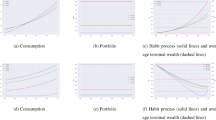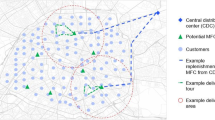Abstract
A pure Hotelling game is a spatial competition between a finite number of players who simultaneously select a location in order to attract as many consumers as possible. In this paper, we study the case of a general distribution of consumers on a network generated by a metric graph. Because players do not compete on price, the continuum of consumers shop at the closest player’s location. If the number of sellers is large enough, we prove the existence of an approximate equilibrium in pure strategies, and we construct it.






Similar content being viewed by others
Notes
Respectively, we define \([x_1,x_2[\), \(]x_1,x_2]\), and \(]x_1,x_2[\) as the set of \(\{(u,v,t)\}\) for \(t\in [t_1,t_2[\), \(]t_1,t_2]\), or \(]t_1,t_2[\).
Remember we can assume without loss of generality that all vertices have degree different from 2, as explained in Sect. 2.1.
Remark that \({{\mathrm{Card}}}(E_L)+\sum _{e \in E} I_e + 2 \sum _{e \in E} \left\lceil \frac{\lambda _e K}{2 \epsilon _1} \right\rceil \le \Omega (\epsilon _1)\) so this constrain vanishes when we ask n to be larger than \(N(\epsilon _1)\)
We consider here only ties on a set with a strictly positive measure.
References
Anderson SP, Goeree JK, Ramer R (1997) Location, location, location. J Econ Theory 77(1):102–127
Eaton BC, Lipsey RG (1975) The principle of minimum differentiation reconsidered: some new developments in the theory of spatial competition. Rev Econ Stud 42:27–49
Fournier G, Scarsini M (2018) Location games on networks: existence and efficiency of equilibria. Math Oper Res. https://doi.org/10.1287/moor.2017.0921
Hotelling H (1929) Stability in competition. Springer, Berlin
Lederer PJ, Hurter AP Jr (1986) Competition of firms: discriminatory pricing and location. Econom J Econom Soc 54:623–640
Montes-Rojas G (2015) Spatial competition and the location of firms with non-uniformly distributed costumers. Revista de Economía Política de Buenos Aires 14:83–107
Neven DJ (1986) On Hotelling’s competition with non-uniform customer distributions. Econ Lett 21(2):121–126
Núñez M, Scarsini M (2016) Competing over a finite number of locations. Econ Theory Bull 4(2):125–136
Núñez M, Scarsini M (2017) Large spatial competition. In: Mallozzi L, D’Amato E, Pardalos PM (eds) Spatial interaction models: facility location using game theory. Springer, Berlin, pp 225–246
Osborne MJ, Pitchik C (1986) The nature of equilibrium in a location model. Int Econ Rev 27:223–237
Pálvölgyi D (2011) Hotelling on graphs. Technical report, Mimeo
Peters H, Schröder M, Vermeulen D (2018) Hotelling’s location model with negative network externalities. Int J Game Theory 47:811–837
Acknowledgements
The author thanks two referees, the Associate Editor, and the Editor for their useful suggestions. Support from the ANR Labex IAST is gratefully acknowledged.
Author information
Authors and Affiliations
Corresponding author
Additional information
This research was supported by the ISF Grant 1585/15.
Appendix
Appendix
Lemma 19
Let \(\epsilon _1 \in (0,\frac{\min \lambda _e K}{2})\), \(\hat{e} \in E\) and \(\hat{i} \in \{0,\ldots ,I_e-1\}\), then \(\Omega (\epsilon _1) \ge h(\frac{\ell _{\hat{e}}g_{\hat{e}}^{\hat{i}}}{10},\epsilon _1)\) .
Proof
It follows from the definition of \(\ell _e\) and the inequality \(m-\epsilon _1 \le g_e \le M + \epsilon _1\) that:
Moreover, because \(x \le \left\lceil x \right\rceil \le x+1\) we also have:
Finally, we use the notation \(L:= \sum _e \lambda _e\) and the fact that \(\sum _e \left\lceil \frac{\lambda _e K}{2 \epsilon _1} \right\rceil \le {{\mathrm{Card}}}(E)+\frac{L K}{2 \epsilon _1}\).
\(\square \)
Lemma 20
If \(n \ge \Omega (\epsilon _1)\) then \(\overline{\theta } \le \frac{\epsilon _1 (M+ \epsilon _1)}{4K}\)
Proof
Remember that \(\overline{\theta }\) was defined in Eq. (8) as a real number such that \(n \le h(\overline{\theta }) \le n+ \sum _{e \in E} I_e\). We suppose here that \(n \ge \Omega (\epsilon _1)\) and we have, thanks to Lemma 19, \(\Omega (\epsilon _1) \ge h(\frac{\ell _e g_e^i}{10},\epsilon _1)\). Putting all these inequalities together gives:
Because h is a decreasing function, and replacing \(\ell \) by its definition in Definition 10, we get:
Using the inequality \(g_e^i \le M+\epsilon \) we obtain:
\(\square \)
Rights and permissions
About this article
Cite this article
Fournier, G. General distribution of consumers in pure Hotelling games. Int J Game Theory 48, 33–59 (2019). https://doi.org/10.1007/s00182-018-0648-4
Accepted:
Published:
Issue Date:
DOI: https://doi.org/10.1007/s00182-018-0648-4




